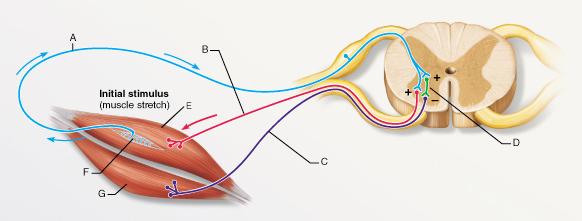
What reaction would occur if the muscle labeled E were suddenly pulled longer?
- the relaxation of muscle E
- the relaxation of the both muscles E and G
- the contraction of muscle E
- the contraction of the both muscles E and G
- the contraction of muscle E
- A sudden stretch in a muscle leads to the contraction of the stretched muscle (E) and the relaxation of the antagonistic muscle (G).
Which cranial nerve transmits information about audition?
- optic
- abducens
- vestibulocochlear
- vagus
- vestibulocochlear
- The vestibular branch of the vestibulocochlear nerve transmits afferent impulses for the sense of equilibrium. The cochlear branch transmits afferent impulses for the sense of hearing.
Which cranial nerve innervates most of the visceral organs?
- accessory
- hypoglossal
- vagus
- abducens
- vagus
- The vagus nerve has many targets in the thoracic and abdominal cavities and innervates many of the visceral organs.
Which of the following carries no sensory information?
- trigeminal nerve
- vestibulocochlear nerve
- hypoglossal nerve
- optic nerve
- hypoglossal nerve
- The hypoglossal nerve carries motor commands to the tongue.
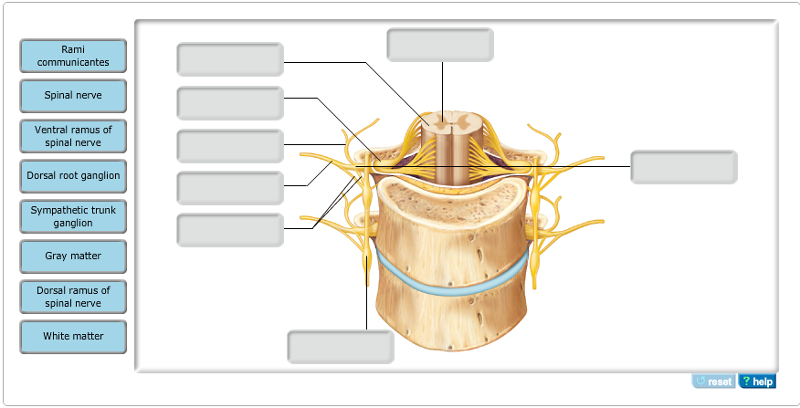
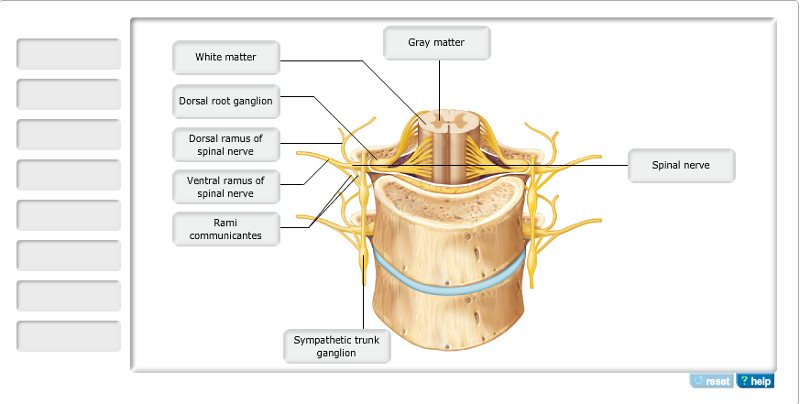
The knee-jerk reflex is an example of a __________.
- tendon reflex
- flexor reflex
- stretch reflex
- superficial reflex
- stretch reflex
- The most familiar clinical example of a stretch reflex is the knee-jerk reflex. The overall goal of a stretch reflex is to maintain a muscle's length and in turn maintain body position. For example, the knee-jerk reflex, during which the knee extensors contract in response to being stretched, helps keep your knees from buckling when you are standing upright.
Which pair below is incorrect?
- cranial nerve VI: eye movement
- cranial nerve III: oculomotor nerve
- cranial nerve III: pupillary constriction
- optic nerve: sensory
- cranial Nerve IV: sensory
- cranial Nerve IV: sensory
- The trochlear nerve is a motor nerve that innervates the superior oblique of the eye.
Which reflex has a contralateral component?
- stretch
- crossed-extensor
- tendon
- flexor
- crossed-extensor
- The crossed-extensor reflex activates opposing actions in the opposite limb.
The phrenic nerve is a branch from the __________.
- brachial plexus
- thoracic spinal cord
- vagus nerve
- cervical plexus
- cervical plexus
- The phrenic nerve, which arises from the cervical plexus, supplies both motor and sensory fibers to the diaphragm, the main breathing muscle.
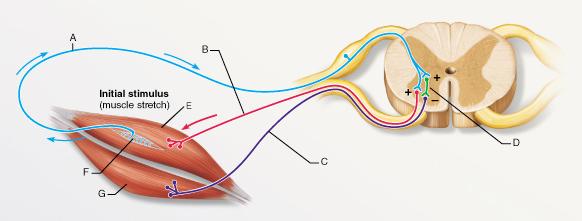
What is the type of reflex represented by the pathway that includes A, D, and C?
- reciprocal inhibition
- stretch reflex
- cross-extension reflex
- flexor reflex
- reciprocal inhibition
- When a muscle is contracted, its antagonist (“reciprocal”) is reflexively relaxed.
The sensory division of the PNS is also known as the efferent division.
- True
- False
- False
- All of the sensory information is considered afferent, or flowing toward the CNS. Efferent means "from the CNS."
__________ are receptors that can respond to painful stimuli.
- Photoreceptors
- Nociceptors
- Mechanoreceptors
- Chemoreceptors
- Nociceptors
- Nociceptors respond to potentially damaging stimuli that result in pain.
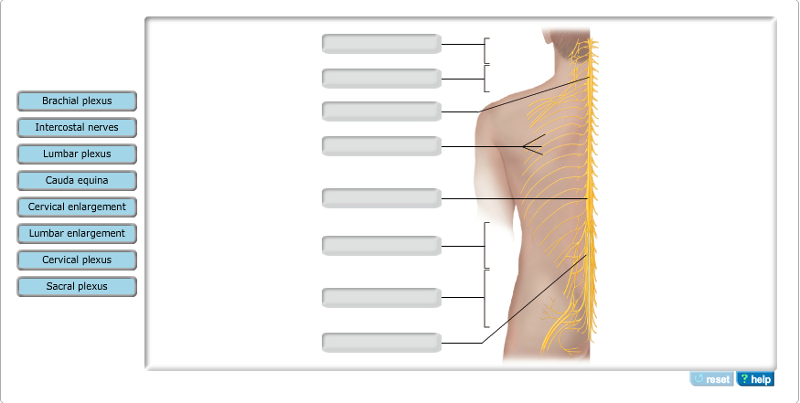
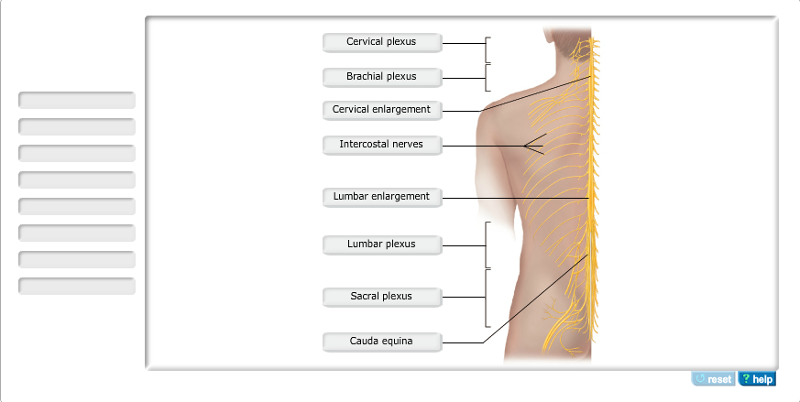
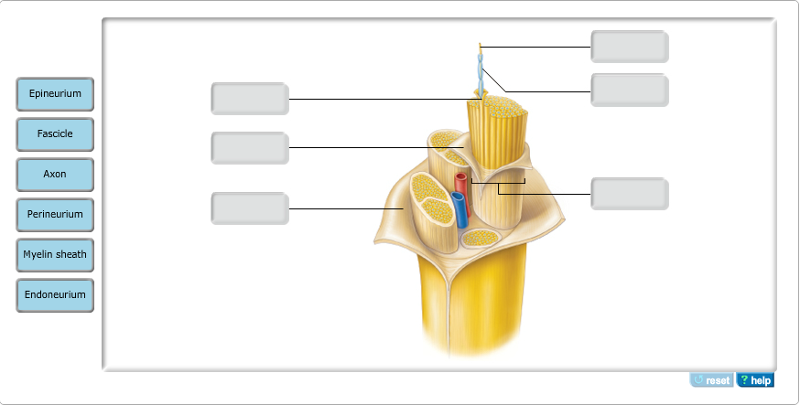
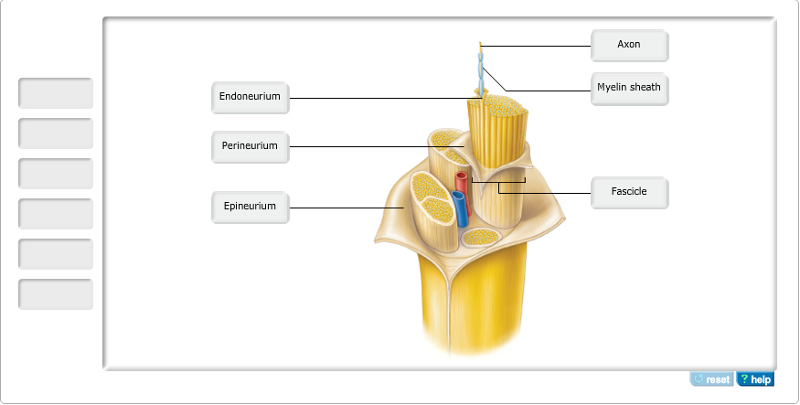
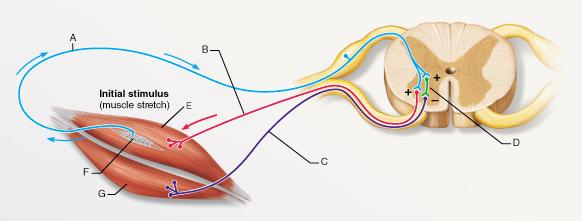
What is the specific function of the structure labeled F?
- increasing tension of the surrounding muscle
- increasing tension of the antagonistic muscle
- determination of muscle tension
- determination of muscle length
- increasing tension of the antagonistic muscle
In carpal tunnel syndrome, the __________ is compressed.
- axillary nerve
- median nerve
- musculocutaneous nerve
- radial nerve
- median nerve
- The median nerve descends through the arm and forearm before passing through the wrist. Compression of this nerve in the anterior wrist causes carpal tunnel syndrome.
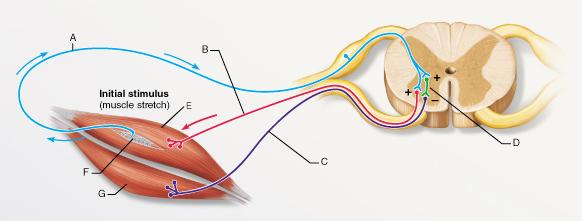
The synapse between which of the following two neurons is a part of a monosynaptic reflex arc?
- A and D
- A and B
- B and C
- A and C
- A and B
- A monosynaptic reflex arc includes a synapse between sensory and motor neurons without the involvement of an interneuron.

Which of the receptor types pictured functions exclusively as a proprioceptor?
- B
- C
- D
- All of the listed responses are correct.
- B
- Proprioceptors are sensitive to stimuli associated with body movements. The muscle spindle shown in B is responsive to muscle stretch.
Which of the following is NOT correct concerning nerves?
- Nerves do not contain cell bodies.
- Nerves are analogous to tracts in the CNS.
- Nerves are covered by an outer sheath called the epineurium.
- Nerves are collection of axons of either sensory or motor neurons but not both.
- Nerves are collection of axons of either sensory or motor neurons but not both.
- Nerves can be mixed collections of both sensory and motor axons.
Which of the following cranial nerves carries only motor information?
- optic
- trigeminal
- olfactory
- abducens
- abducens
- The abducens carries efferent (motor) signals to the extrinsic eye muscle that abducts the eye (turns it laterally).